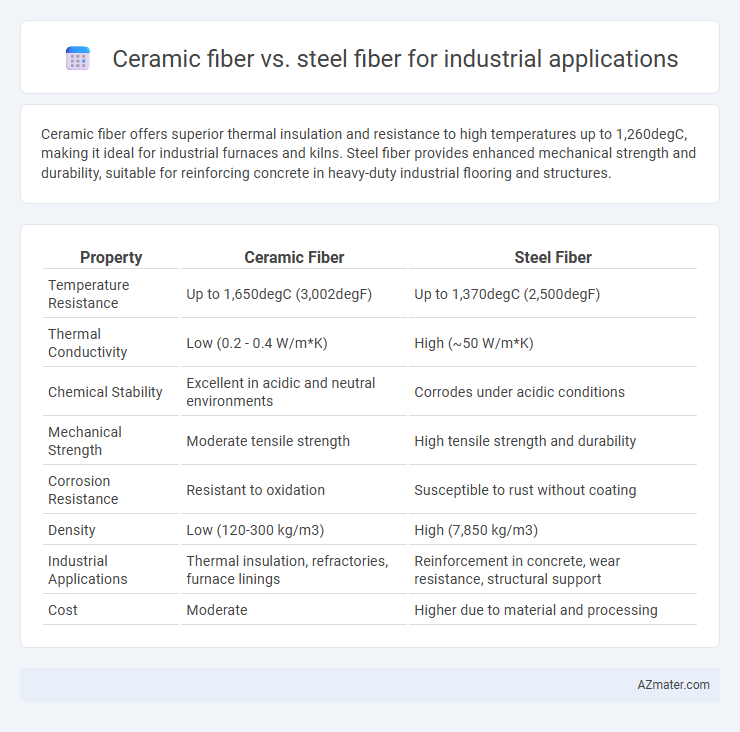Ceramic fiber offers superior thermal insulation and resistance to high temperatures up to 1,260degC, making it ideal for industrial furnaces and kilns. Steel fiber provides enhanced mechanical strength and durability, suitable for reinforcing concrete in heavy-duty industrial flooring and structures.
Table of Comparison
| Property | Ceramic Fiber | Steel Fiber |
|---|---|---|
| Temperature Resistance | Up to 1,650degC (3,002degF) | Up to 1,370degC (2,500degF) |
| Thermal Conductivity | Low (0.2 - 0.4 W/m*K) | High (~50 W/m*K) |
| Chemical Stability | Excellent in acidic and neutral environments | Corrodes under acidic conditions |
| Mechanical Strength | Moderate tensile strength | High tensile strength and durability |
| Corrosion Resistance | Resistant to oxidation | Susceptible to rust without coating |
| Density | Low (120-300 kg/m3) | High (7,850 kg/m3) |
| Industrial Applications | Thermal insulation, refractories, furnace linings | Reinforcement in concrete, wear resistance, structural support |
| Cost | Moderate | Higher due to material and processing |
Introduction to Industrial Fiber Reinforcement
Industrial fiber reinforcement enhances material strength and durability by integrating fibers such as ceramic and steel into composites. Ceramic fiber offers high-temperature resistance, excellent thermal insulation, and chemical stability, making it ideal for furnace linings and thermal barriers. Steel fiber provides superior mechanical strength, impact resistance, and improved toughness, commonly used in concrete reinforcement and heavy-duty structural components.
Overview of Ceramic Fiber Properties
Ceramic fiber exhibits exceptional thermal insulation properties, withstanding temperatures up to 2300degF (1260degC) while maintaining low thermal conductivity and high chemical inertness, making it ideal for high-temperature industrial applications. Its lightweight and flexible nature provide excellent resistance to thermal shock, corrosion, and oxidation compared to steel fiber, which offers superior mechanical strength but limited heat resistance. The combination of low density and high melting point gives ceramic fiber a competitive advantage in furnace linings, heat shields, and refractory materials within industries like metallurgy and petrochemicals.
Key Characteristics of Steel Fiber
Steel fiber exhibits exceptional tensile strength, high modulus of elasticity, and outstanding durability under extreme mechanical stress, making it ideal for reinforcing concrete in industrial applications. Its corrosion resistance and high impact resistance enhance structural longevity in aggressive environments, while its flexibility supports crack control and improves load-bearing capacity. These key characteristics position steel fiber as a superior choice for demanding industrial projects requiring enhanced toughness and structural integrity.
Comparative Mechanical Strength
Ceramic fibers exhibit high tensile strength and excellent thermal stability, making them ideal for high-temperature industrial applications where resistance to heat-induced deformation is critical. Steel fibers provide superior impact resistance and tensile strength under mechanical loading, supporting structural reinforcement in concrete and composite materials. The choice between ceramic and steel fibers depends on operating temperature requirements and the specific mechanical stress profile of the industrial environment.
Thermal Performance Differences
Ceramic fiber offers superior thermal insulation with resistance to temperatures exceeding 1400degC, making it ideal for high-temperature industrial applications requiring minimal heat loss. Steel fiber provides moderate thermal conductivity but excels in structural reinforcement rather than insulation, tolerating temperatures up to around 600degC. Industrial environments demanding energy efficiency and high-temperature stability benefit more from ceramic fiber due to its low thermal conductivity and excellent heat retention properties.
Chemical and Corrosion Resistance
Ceramic fiber exhibits superior chemical resistance and corrosion resistance compared to steel fiber, making it ideal for high-temperature industrial environments exposed to aggressive chemicals and oxidizing agents. Steel fiber tends to corrode and degrade in acidic or saline conditions, whereas ceramic fiber maintains structural integrity and provides excellent resistance to chemical attack. The inherent inertness and oxidation resistance of ceramic fiber significantly extend the lifespan and reliability of industrial insulation and reinforcement applications.
Cost Analysis: Ceramic vs Steel Fiber
Ceramic fiber generally has a higher initial cost than steel fiber due to its specialized manufacturing process and heat-resistant properties, making it ideal for extreme temperature applications. Steel fiber, while typically less expensive per unit, offers greater tensile strength and durability, which can reduce maintenance and replacement costs in industrial environments. In long-term cost analysis, the choice depends on application-specific factors such as temperature tolerance, lifespan, and thermal insulation requirements, where ceramic fibers excel but steel fibers provide a cost-effective solution for structural reinforcement.
Typical Industrial Applications
Ceramic fiber excels in high-temperature insulation, thermal barriers, and refractory linings for furnaces, kilns, and boilers due to its superior heat resistance and low thermal conductivity. Steel fiber is widely used in concrete reinforcement, shotcrete for tunnels, and industrial flooring to enhance tensile strength and durability under mechanical stress. Both fibers serve crucial roles, with ceramic fiber optimizing thermal performance in extreme heat environments, while steel fiber improves structural integrity in heavy-duty industrial applications.
Installation and Maintenance Considerations
Ceramic fiber offers lightweight properties and excellent thermal insulation, making installation faster and reducing labor costs compared to heavier steel fiber, which requires more handling equipment and time. Maintenance of ceramic fiber involves regular inspection for fiber degradation and replacement due to susceptibility to high-temperature damage, while steel fiber demands less frequent replacement but may require corrosion protection and structural integrity monitoring. Choosing between ceramic and steel fibers depends on the industrial environment, balancing easier installation of ceramic fiber against the durability and lower maintenance frequency of steel fiber.
Selecting the Optimal Fiber for Industrial Needs
Ceramic fiber offers superior heat resistance and excellent thermal insulation, making it ideal for high-temperature industrial applications such as furnaces and kilns. Steel fiber provides enhanced mechanical strength, durability, and impact resistance, which benefits concrete reinforcement and heavy-load-bearing operations. Selecting the optimal fiber depends on balancing thermal performance requirements with structural strength, where ceramic fibers excel in insulation and steel fibers are preferred for toughness and load capacity.

Infographic: Ceramic fiber vs Steel fiber for Industrial application
 azmater.com
azmater.com